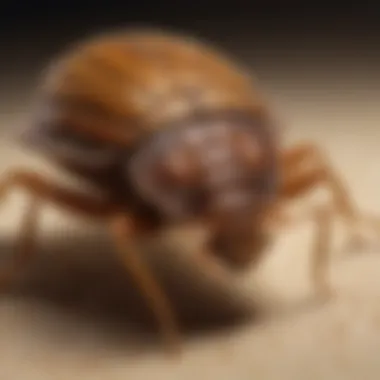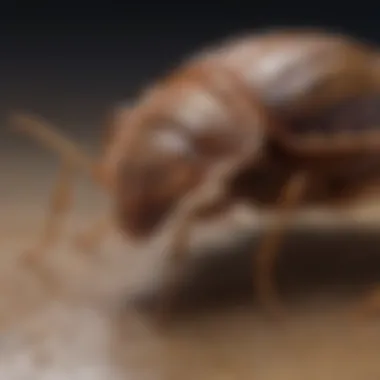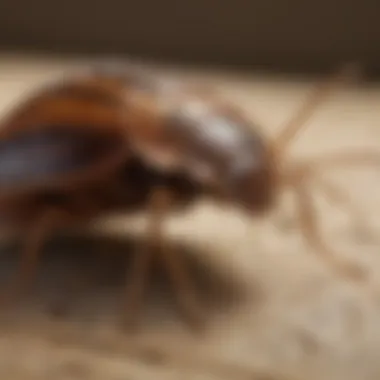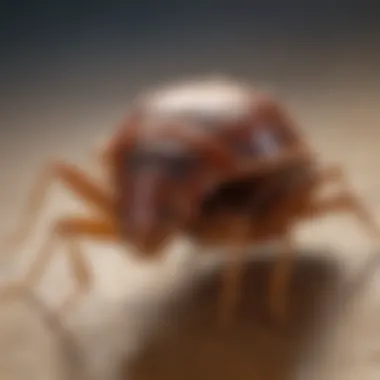Evaluating Cyonara 9.7 for Effective Bed Bug Control


Intro
Bed bugs remain a persistent issue in many households, causing discomfort and anxiety. Understanding how to manage and eliminate these pests is crucial. In recent years, various insecticides have emerged in the market. One product of interest is Cyonara 9.7. This article intends to dissect the efficacy of Cyonara 9.7, providing insights into its formulation, application methods, and safety.
Understanding Pests
Definition of Pests
Pests are organisms that cause harm to human interests, whether that be agricultural, environmental, or health-related. Bed bugs, scientifically known as Cimex lectularius, fall into this category. These small, brownish insects feed on the blood of humans and animals. Their presence can lead to discomfort due to their bites and can also be a source of significant distress in affected households.
Importance of Pest Identification
Identifying the specific type of pest is vital for effective treatment. Misidentifying bed bugs can lead to ineffective control measures. Knowing their behavior and habitat is essential. Bed bugs are nocturnal and typically hide during the day, making inspection difficult. Recognizing the signs of their presence, such as bites and shed skins, is crucial in addressing an infestation early.
The Role of Cyonara 9.
Cyonara 9.7 is a pyrethroid-based insecticide designed to target a variety of pests, including bed bugs. The active ingredient, lambda-cyhalothrin, interferes with the pests' nervous systems. It acts quickly and has a long residual effect, making it a popular choice among pest management professionals and homeowners.
Application Methods
Cyonara 9.7 can be applied in several ways:
- Sprays: For targeted treatment in infested areas.
- Residual Treatments: Applied to surfaces to provide prolonged protection.
It is important to follow the manufacturer's guidelines carefully to ensure safety and effectiveness.
Safety Considerations
When dealing with insecticides, safety is always a top priority. Cyonara 9.7 is generally considered safe when used according to the label instructions. However, precautions are necessary:
- Wear protective gear like gloves and masks when applying.
- Keep children and pets away from treated areas until dry.
"Proper use of insecticides like Cyonara 9.7 can significantly reduce the risk of infestation if combined with good hygiene practices."
Eco-Friendly Pest Control Solutions
Overview of Sustainable Practices
Eco-friendly pest control focuses on sustainable practices that minimize environmental impact. Solutions can combine chemical and non-chemical methods. Integrated Pest Management (IPM) emphasizes long-term prevention through a combination of techniques. This strategy not only targets the pests but also addresses the conditions that foster their presence.
Natural Remedies and Their Effectiveness
There are also natural remedies available. Some common options include:
- Diatomaceous earth: A powder that dehydrates bed bugs.
- Essential oils: Such as tea tree oil, which some studies suggest can repel bed bugs.
While these methods may be less toxic, their effectiveness can vary significantly compared to synthetic options like Cyonara 9.7.
Closure
In sum, understanding pests and evaluating products like Cyonara 9.7 is vital for effective pest control. Homeowners must consider both effectiveness and safety in their choice of treatment for bed bug infestations. Through comprehensive analysis, this article will cover all aspects of Cyonara 9.7, shedding light on its role in pest management.
Prolusion to Bed Bugs
Bed bugs, small and elusive pests, have become a significant concern for homeowners. Their ability to infest homes silently makes them a frequent topic of discussion. In this article, we explore the impact these insects have on living conditions and the effectiveness of products like Cyonara 9.7 for managing infestations. Understanding bed bugs is crucial in addressing the issues related to their presence.
Understanding Bed Bug Biology
Bed bugs are scientifically known as Cimex lectularius. These nocturnal insects thrive on the blood of humans and animals. Adult bed bugs can live for several months without feeding, allowing them to survive long periods between host encounters. They reproduce quickly; a single female can lay hundreds of eggs in her lifetime, leading to a rapidly growing population if not controlled.
Anatomy plays a role in their concealment abilities. Bed bugs are flat, oval-shaped, and typically brownish in color, making them difficult to spot against most surfaces. Their size, roughly the width of a credit card, aids in their ability to hide in tiny crevices, such as seams of mattresses or behind wallpaper.


Signs of Bed Bug Infestation
Identifying the presence of bed bugs early can help in managing an infestation before it escalates. Common signs include:
- Bite marks: Usually appear as small, red, and itchy welts on the skin, typically located in clusters.
- Dark spots: These are often fecal stains left behind on sheets and bedding.
- Eggs and exuviae: Tiny, white eggs and skins shed by nymphs can be found in hiding spots.
- Unpleasant odor: A musty smell may indicate a larger infestation due to the scent glands of the bugs.
Recognizing these indicators is essential for taking prompt action against bed bug infestations. Proper knowledge leads to timely interventions, ultimately minimizing discomfort and disruption.
Overview of Cyonara 9.
Cyonara 9.7 plays a significant role in pest control, particularly against bed bugs. Understanding its properties is crucial for homeowners dealing with infestations. This overview provides insights into the chemicals that comprise Cyonara 9.7, its mechanism of action, and the potential benefits it offers.
Chemical Composition
Cyonara 9.7 contains two active ingredients: Lambda-cyhalothrin and Piperonyl butoxide. Lambda-cyhalothrin is a synthetic pyrethroid, known for its rapid knockdown effect on a variety of insects. Its strength lies in disrupting the normal functioning of the insect's nervous system.
Piperonyl butoxide, on the other hand, acts as a synergist. It enhances the efficacy of the Lambda-cyhalothrin by inhibiting the enzyme activity that would normally break down the pesticide in an insect's body. This combination allows for more effective control over bed bugs and other pests, making Cyonara 9.7 a potent solution.
Mode of Action
The mode of action for Cyonara 9.7 primarily revolves around its ability to target the nerve receptors in bed bugs. When an insect walks over a treated surface, the active ingredients attach to their exoskeleton, entering their systems. This affects their neuromuscular coordination, leading to paralysis and death. It is noteworthy that this action is not instantaneous; bed bugs will exhibit symptoms of distress before succumbing.
Using Cyonara 9.7, homeowners should expect a considerable reduction in bed bug population in a short amount of time, but it is essential to follow proper application guidelines. An effective bed bug control strategy might include thorough cleaning and removing clutter, which can enhance the effectiveness of the insecticide.
"The combination of Lambda-cyhalothrin and Piperonyl butoxide in Cyonara 9.7 targets the insects at their core, ensuring effective pest control when used correctly."
Understanding these elements helps to clarify how Cyonara 9.7 is designed to work against bed bugs. Its chemical composition and mode of action underline the importance of selecting the right pest control solution to address infestations effectively.
Application Guidelines for Cyonara 9.
Understanding Application Guidelines for Cyonara 9.7 is crucial for effective bed bug control. Proper application maximizes the product’s effectiveness while minimizing unintended consequences. Following the guidelines ensures homeowners achieve the best results without compromising safety. Consideration of various factors, such as dosage and application techniques, directly influences outcomes in pest management.
Recommended Dosage
The dosage of Cyonara 9.7 is a key factor in its effectiveness. Using too little may not eliminate bed bugs, while too much can increase exposure risks. The manufacturer’s instructions provide a baseline for dosage, typically indicated in ounces per gallon of water. For effective treatment, a common recommendation is 0.5 to 1.0 ounces per gallon. Additionally, it’s vital to apply this solution to areas where bed bugs are likely to hide, such as:
- Mattresses
- Bed frames
- Couches and chairs
- Cracks and crevices in walls
Adhering to the suggested dosage not only aids in controlling the pest population but also ensures that surrounding environments remain safe.
Best Practices for Application
Effective application of Cyonara 9.7 requires attention to detail and a few best practices:
- Preparation: Clear the area where application will occur. This includes moving furniture and washing bed linens. A clean space enhances the effectiveness of the solution.
- Protective Gear: Always wear appropriate protective equipment, which may include gloves and masks. This minimizes any potential exposure to chemicals.
- Targeted Application: Focus on key areas where bed bugs congregate. This maximizes contact and efficacy. Spraying thoroughly in hidden spots increases chances of eliminating pests.
- Timing: Consider the time of day for application. Many prefer late evening or night when bed bugs are more active. This may improve interaction with the insecticide.
- Follow-Up Treatments: Depending on the severity of the infestation, multiple treatments may be necessary. Monitor the effectiveness of the application and respond as needed.
Important: Always review the product label for any specific instructions or safety warnings. Ignoring these can lead to ineffective treatment or potential hazards.
Implementing these practices not only enhances the treatment’s potency but also contributes to long-term bed bug management. Taking a structured approach to application ensures a more successful outcome and aids in restoring peace at home.
Efficacy of Cyonara 9. Against Bed Bugs
The efficacy of Cyonara 9.7 as a pest control solution against bed bugs is a critical aspect to evaluate. Bed bugs are notorious pests that can cause discomfort and distress to those infested. Effective control measures are essential for ensuring a safe and comfortable living environment. Cyonara 9.7 has gained attention due to its unique formulation and claimed effectiveness against these resilient insects. This section addresses the effectiveness of Cyonara 9.7 through laboratory studies and real-world field trials, offering insights into its practical applications.
Laboratory Studies on Effectiveness
Laboratory studies provide a controlled environment to measure the effectiveness of Cyonara 9.7. Researchers usually expose bed bugs to different concentrations of the insecticide to observe its impact. Studies have shown that the active ingredients in Cyonara 9.7, such as alpha-cypermethrin, can effectively paralyze and kill bed bugs upon contact.
For instance, a specific study demonstrated that doses as low as 0.5% could lead to a substantial reduction in bed bug populations within a short time frame. Researchers maintained various conditions such as temperature and humidity to simulate real-life scenarios. The findings suggest that Cyonara 9.7 is capable of significantly reducing bed bug numbers when applied properly.
Here are some key points from laboratory findings:


- Rapid Knockdown: Cyonara 9.7 has shown a quick knockdown effect, immobilizing bed bugs swiftly.
- Residual Activity: The residue left by the application continues to kill newly introduced bed bugs, offering long-term protection.
- Resistance Testing: Studies show it remains effective even against bed bugs that have developed resistance to other insecticides.
Field Trials and User Experiences
Field trials shift focus from controlled settings to real-world applications, providing valuable data regarding effectiveness in everyday scenarios. In several case studies involving homeowners and pest control professionals, Cyonara 9.7 demonstrated its efficacy in various residential environments.
Users reported positive experiences, particularly in hard-hit areas where bed bugs thrive. In these trials, pest control specialists applied Cyonara 9.7 strategically in infested locations. Homeowners noted a significant decrease in bed bug sightings shortly after treatment. A notable finding was that individuals who followed recommended application guidelines experienced better outcomes.
Feedback from users includes:
- Prevention of Reinfestation: Those who re-treated their spaces found that they could maintain control over time.
- Ease of Use: Many appreciated the straightforward application process, allowing them to address infestations effectively.
- Safety Concerns: Some expressed initial concerns about safety but reported feeling more secure once the product's instructions were closely followed, emphasizing the importance of adhering to safety guidelines.
In summary, both laboratory studies and field trials indicate that Cyonara 9.7 can be an effective tool against bed bugs, provided it is used as directed. Further analysis, particularly on long-term effects and integration into comprehensive pest management plans, could help solidify its place as a reliable option for bed bug control.
Safety Considerations
Safety considerations are essential when dealing with any pest control solution, including Cyonara 9.7. With increased concerns about health and environmental impact, understanding the risks associated with chemical treatments is vital for homeowners. This section will highlight potential human exposure risks along with environmental implications, both of which are critical for making informed decisions regarding pest management. Evaluating these aspects can help mitigate risks while effectively addressing bed bug infestations.
Human Exposure Risks
Human exposure to pesticides like Cyonara 9.7 stems from various factors, including application methods, dosage, and presence during treatment. The active ingredients, as identified in previous sections of this article, can pose health risks if not managed properly. Common exposure routes include inhalation, ingestion, and dermal contact.
To minimize risks, consider the following guidelines:
- Ventilation: Ensure windows and doors are open during and after application. This helps to dissipate any harmful vapors in the air.
- Personal Protective Equipment (PPE): Wear appropriate gear, such as gloves and masks, during application to reduce direct contact with the substance.
- Pets and Children: Keep children and pets away from treated areas for at least 24 hours post-treatment. This helps prevent accidental exposure to residual chemicals.
It is essential that sypectators follow label instructions regarding the application of Cyonara 9.7 to effectively limit human exposure risks. By adhering to safety guidelines, individuals can protect their health while effectively combating bed bug infestations.
Environmental Impact
The environmental impact of using chemical pesticides raises valid concerns, especially when it comes to the potential effects on non-target organisms and ecosystems. Cyonara 9.7's formulation can affect local flora and fauna if not applied carefully. Understanding its breakdown, persistence, and route of entry into the environment is crucial.
Key considerations include:
- Runoff: During rainfall, chemicals can be washed from treated surfaces into nearby waterways, affecting aquatic life.
- Pollinator Safety: Insecticides can harm beneficial insects, such as bees, if they are exposed to treated areas. Opting for targeted applications can help protect these essential species.
- Soil Health: Pesticides might alter soil composition and microbial health, creating long-term impacts on ground ecosystems.
Alternatives to Cyonara 9.
Evaluating alternatives to Cyonara 9.7 is an important aspect of pest control, particularly for homeowners facing bed bug infestations. These alternatives can offer various benefits, including differing mechanisms of action, safety profiles, and environmental impacts. For many, finding a solution that aligns with personal preferences or safety concerns is essential.
Some individuals may prefer non-chemical methods, which can reduce the risk of exposure to potentially harmful substances. Others may seek alternative chemical treatments that may be more effective due to their unique formulations. By examining both categories, we can better understand how to tackle bed bug issues comprehensively.
Non-Chemical Solutions
Non-chemical solutions offer effective strategies without the potential risks associated with insecticides. Several methods are available:
- Heat Treatment: This process involves raising the temperature of infested areas to levels lethal for bed bugs. High heat can reach all the nooks and crannies where these pests hide, effectively eliminating them.
- Diatomaceous Earth: This natural powder is derived from fossilized algae and can desiccate insects upon contact. It acts mechanically rather than chemically, which avoids the potential issues of toxicity.
- Vacuuming: Regular vacuuming can remove bed bugs and their eggs from surfaces. This method is effective when used in conjunction with other treatments.
Passive methods like these can be beneficial for sensitive individuals or for those who prefer organic solutions. They can also serve as complementary treatments alongside chemical insecticides for enhanced effectiveness.
Other Chemical Treatments
While Cyonara 9.7 is a widely recognized option, several other chemical treatments may also offer viable solutions:
- Temprid FX: This insecticide combines two active ingredients that provide a fast kill and long-lasting residual effect against bed bugs.
- Bed Bug Killer by EcoSMART: An organic option that uses plant-based ingredients. It provides a safer alternative for those concerned about environmental impact and safety around children and pets.
- Pyrethroid Insecticides: These are synthetic chemicals modeled after natural insecticides found in chrysanthemum flowers. They have a high efficacy rate but may develop resistance over time.
Choosing an alternative depends on numerous factors, including the severity of the infestation, the desired speed of eradication, and concerns regarding safety. Each treatment may vary in effectiveness, so it is advisable to consider these alternatives critically.
Key Takeaway: Various alternatives exist to Cyonara 9.7 that can cater to different needs, preferences, and values related to pest control. Understanding these options can empower homeowners to make informed decisions regarding their bed bug management strategies.
Combining Methods for Better Results


Combining different pest control methods can greatly improve the effectiveness of bed bug management. Relying solely on one method may not suffice against the resilient nature of bed bugs. The need for a multi-faceted approach arises from the bugs’ ability to adapt to various pesticides, including Cyonara 9.7. Thus, integrating various strategies can yield better outcomes than using a single approach alone. This may involve combining chemical treatments with non-chemical measures, ultimately leading to a more robust defense against infestations.
Integrated Pest Management Strategies
Integrated Pest Management (IPM) is a holistic approach to pest control that emphasizes prevention while minimizing risks to human health and the environment. It incorporates several tactics:
- Monitoring: Regular inspection and monitoring are essential to identify potential infestations early. Utilize traps or visual checks to assess the presence of bed bugs.
- Sanitation: Keeping living spaces clean reduces hiding spots for bed bugs. Vacuuming regularly and laundering bedding at high temperatures are effective steps.
- Mechanical Control: Consider using encasements for mattresses and box springs. This physical barrier can trap existing bugs and prevent new ones from entering.
- Chemical Control: Cyonara 9.7 may be used in combination with other insecticides known to affect different life stages of bed bugs. This allows targeting them more effectively.
Adopting IPM strategies encourages a thorough understanding of the pest problem, leading to informed decision-making and better outcomes.
When to Seek Professional Help
While many homeowners attempt to manage bed bug issues on their own, there are situations where professional assistance may be necessary. Recognizing these scenarios is important for effective management:
- Severe Infestation: If the infestation is extensive, the resources needed to control it may outweigh personal efforts. In such cases, professional pest management services equipped with the right tools are crucial.
- Efficiency Needed: Professionals have access to a wider range of treatment options, many of which are not available to the general public. This includes more effective chemicals and advanced techniques.
- Health Concerns: Allergic reactions or health concerns related to pesticide exposure should prompt an immediate call to a professional. Ensuring safety is a priority.
Culmination
In summarizing the discussion around Cyonara 9.7, it is essential to highlight its significance and practical implications for dealing with bed bug infestations. This article has reviewed various dimensions of Cyonara 9.7, including its chemical composition, mode of action, and application guidelines. The need for effective pest control solutions cannot be overstated, especially in the context of rising bed bug populations and the challenges they pose to homeowners and pest control professionals.
Summary of Findings
The findings indicate that Cyonara 9.7 contains active ingredients that are potent against bed bugs. Laboratory studies have demonstrated its effectiveness through rigorous testing protocols. Field trials and user experiences further confirm that when applied correctly, Cyonara 9.7 not only exterminates adult bed bugs but also affects different life stages, helping to reduce the possibility of re-infestation.
Moreover, the safety considerations explored highlight that while Cyonara 9.7 is generally safe when used as directed, precautions should be implemented to minimize any potential risks to human health and the environment. These findings contribute to the understanding of Cyonara 9.7 as a viable option among pest control solutions.
Recommendations for Homeowners
For homeowners facing bed bug issues, Cyonara 9.7 offers a promising solution, but it is crucial to follow best practices when utilizing this insecticide. Here are several recommendations:
- Follow the label instructions carefully: Adhering to specific dosage and application guidelines can enhance effectiveness and safety.
- Use in combination with integrated pest management strategies: Combining Cyonara 9.7 with non-chemical methods, such as heat treatment and thorough cleaning, can provide more comprehensive control.
- Monitor the treated area: After application, maintain vigilance for any signs of remaining pests, allowing for timely follow-up measures if necessary.
- Consider professional treatments: If the infestation is severe or persists, reaching out to pest management professionals may be the best course of action.
"Using Cyonara 9.7 effectively requires both understanding its properties and implementing strategic control methods."
References and Further Reading
The section on references and further reading is crucial in reinforcing the credibility of the findings presented throughout the article. Incorporating reliable sources allows readers to explore more in-depth information, helping them make informed decisions regarding pest control methods. This component is not just an appendix; it is an integral part that supports the discourse on the efficacy of Cyonara 9.7 against bed bugs.
By providing references, the article acknowledges the broader research landscape surrounding bed bug control. Homeowners can understand the context of the recommendations made in the text. Knowledge of scientific studies related to bed bug treatments provides insights into both the challenges of eradication and the advancements in control methods.
Further, the inclusion of guides for pest management offers practical advice. Readers often seek actionable steps to address their concerns, and these resources can empower them to take charge of their home environment. The benefits of a well-curated reference section include:
- Enhanced knowledge base for readers.
- Credible validation of claims made in the article.
- Access to varied perspectives on pest control methodologies.
In summary, dedicating a section to references and further reading not only enriches the article but also enhances the reader's trust in the information provided.
Scientific Studies on Bed Bug Control
Scientific research plays an important role in understanding bed bug behavior and control. Numerous studies investigate the effectiveness of various insecticides, including Cyonara 9.7. These studies often assess the active ingredients and their potency against bed bugs in controlled environments.
Among the notable research findings are the evaluations of Cyonara 9.7 under laboratory conditions. Results consistent across studies indicate a high efficacy in killing bed bugs at various life stages. Such insights can assist homeowners in understanding the limits and strengths of treatments used.
Some key takeaways from scientific studies include:
- Active Ingredient Analysis: Many studies focus on the role of active ingredients in insecticides. This analysis often shows how certain components interact with the biology of bed bugs.
- Dose-Response Relationship: Research offers insights on how different dosages impact effectiveness. Understanding the right dosage is vital for achieving optimal results in pest control.
- Long-Term Effects: Some studies evaluate whether a treatment causes resistance over time. Knowledge of resistance patterns can guide homeowners on when to rotate products.
Accessing peer-reviewed studies allows readers to delve deeper. It also illustrates the continuous quest for effective strategies against bed bugs.
Guides for Home Pest Management
Following the review of scientific studies, guides for home pest management become a valuable resource. These guides provide practical tips based on established research and field experience. Homeowners can benefit from straightforward advice tailored to their needs.
A few components you might find in pest management guides are:
- Prevention Measures: Tips on preventing bed bugs from entering the home. This may include regularly inspecting bedding and sealing entry points.
- Integrated Pest Management: Guidance on combining various control methods for more effective results. For instance, combining chemical treatments with non-chemical tactics strengthens overall management strategies.
- When to Consult Professionals: Clear criteria on when it might be necessary to contact pest control experts. Knowing when do-it-yourself methods may fall short helps avoid exacerbating infestations.
Therefore, readers can take actionable steps to protect their homes. These guides bridge the gap between academic research and everyday practice, making them essential for effective pest management.



